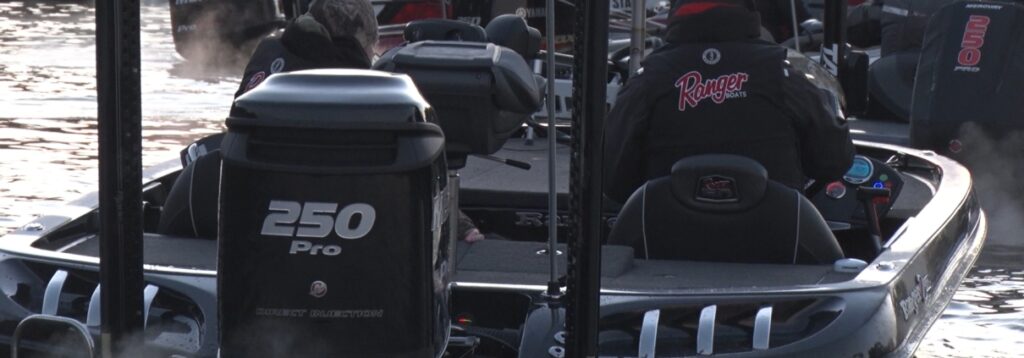By David A. Brown
Call it high hopes in low water. Lake Amistad’s down about 45 feet, but Midland, Texas pro Tim Flowers suspects this Rio Grande reservoir could be ready for a full-throttle spring throw-down just in time for the Texas Team Trail presented by Bass Pro Shops and Cabela’s.

Flowers spends about 150 days a year in Del Rio, so he stays in tune with Amistad’s status. Speaking about two weeks prior to the March 27 tournament, he explained that the low water will have a couple of inescapable impacts; but thankfully, this storied lake holds enough potential to overcome the impediments.
For one thing, extreme low water shrinks the playing field, so Flowers expects Amistad to fish smaller than at full pool. That being said, this sprawling reservoir with its multiple arms and numerous pockets will still offer lots of room for anglers to spread out.
“I think the whole lake will be in play,” Flowers said. “There’s not as much healthy grass as there has been in previous years because the cold weather we had in February knocked it back.
“But the fishing has been good all over the lake from the San Pedro arm, to the Devil’s River and the Rio Grande. All of it has been pretty good.”
Another consideration — water clarity. Low water leaves a lot more of the dry, dusty stuff exposed to the elements and that can lead to high levels of turbidity.
“March has been awfully windy, which dirties up the water,” Flowers said. “All the caliche (light-colored sedimentary rock comprising gravel and sand bound by calcium carbonate) and the white rock is exposed right now so when we get those big winds, some of the pockets get blown out, depending on wind direction.
“But if we can get a couple days without wind, it will be the typical Amistad — pretty clear down near the dam. Of course, as you get up the river, it gets a little more off-colored.”
Flowers said the International Boundary and Water Commission hasn’t pulled significant levels of water since mid-February, when the historic winter storm necessitated increased power generation. Recent weeks have seen little fluctuation and Flowers considers this a good thing.
“Normally, this time of year, they start pulling water to send down for (agricultural needs), but right now is holding steady,” he said. “We’re hoping it stays up for the hydrilla and the spawn.”
ALMOST GO TIME
Looking at seasonal developments, Flowers said he anticipates a mix of prespawn, spawn and spawning activity. It’s difficult to predict precisely where the process will be during the tournament, but Amistad’s bass population should support a mixed-bag expectation.
“It’s about time for the spawn,” he said. “There’s a wave of fish wanting to come up and by the tournament, we could have fish in all three stages.
“The water should be warming in the days leading up to the tournament. Some of the water has gotten up to 65 degrees in some of the backs pockets and it’s about 60 on the main lake. I expect it to continue warming and the fish are going to want to come up and spawn.”
Flowers said prespawners will be utilizing hydrilla, points and drains for their staging. It’s the usual deal, with hefty females parking on strategic feeding spots just outside their intended bedding areas. After they finish their business, postspawners will utilize these same areas.
The spawners typically look for hard gravel banks and grass edges — inside or outside. One thing anglers must consider is that, due to its clarity, Amistad bass often spawn much deeper than other Texas lakes.
“They could spawn from a foot to 22 feet,” Flowers said. “That’s a big range, but I’ve caught them out in 22 feet. It probably averages 3-15 feet, depending where you are.
“Up in the river area, they usually spawn out to 10 feet, but on the main lake, it can be out to 20.”
In typical years, spring at Amistad sees a lot of bladed jigs, lipless crankbaits, Texas-rigged worms and Carolina rigs. Football jigs, flipping jigs, shaky heads and swimbaits will also find their place in the rotations.
THE PROJECTION
Created in 1969 by the construction its namesake dam, Lake Amistad is managed jointly by the governments of the United States and Mexico through the IBWC. Its Spanish name means “friendship” and, hopefully, Amistad will be in a friendly mood on tournament day. If so Flowers believes the winners will need a strong sack.
“I think it will take about 25 to win it and I think it will drop off fast after that. There will be a handful of 20 pound bags, but the big fish in that 5- to 8-pound range are harder to come by. Somebody will catch 2 of them 5-8 pounds and .”
As Flowers points out, Amistad definitely has the potential to deliver a winning sack on one general area. In all likelihood, it’ll take multiple options to earn the W; and that could mean fishing multiple regions.
“You could pull up on a little wolf pack or a school of prespawners, but right now, there hasn’t been a lot of schools of fish,” Flowers said. “By the tournament, there could be some better schools set up where a guy could maybe win it off of one spot.
“The way it’s been fishing lately, it’s kind of a one- or two-fish deal here and there. I think the winners will have to move around to win. It could be won anywhere.”
Teams will take off at safe light from the Diablo East ramp off Highway 90, Del Rio, Texas. The weigh-in will also take place at Diablo East, beginning at 3 p.m.
The Texas Team Trail consists of four regular-season events and a year-end championship. Each regular season event is a one-day team tournament and delivers 100 percent payback, including a fully-rigged 18-foot, 150-horsepower bass boat guaranteed as the first-place prize.
Registration is ongoing for the back-to-back Sam Rayburn events (May 7-8) and can be completed online by visiting www.texasteamtrail.com/tournaments/register/. For more information on rules and tournament payouts, visit www.texasteamtrail.com.

